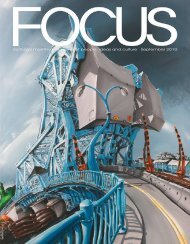***Mar 2006 Focus pg 1-32 - Focus Magazine
***Mar 2006 Focus pg 1-32 - Focus Magazine
***Mar 2006 Focus pg 1-32 - Focus Magazine
Create successful ePaper yourself
Turn your PDF publications into a flip-book with our unique Google optimized e-Paper software.
eport, created just before the ads were runlast fall, based the number of jobs on a projectcost of $942 million. But the CRD has beensaying since 2010 that the project would cost$783 million. Moreover, Ernst & Young useda multiplier in their calculations that was pickedfrom a Federation of Canadian Municipalities’table. They picked a multiplier for 2008/09instead of one for 2012. The net effect of thesetwo errors was to double the estimated jobcreation of the project.As we will see in the last segment of thisstory, job multipliers are, in any case, essentiallymeaningless in terms of predicting thelocal impact of a construction project. Choosingthe wrong job multiplier is bad enough. Butgetting the project cost wrong? Bring back thedeath penalty.I asked both Ernst & Young and the CRD’sWormald about how those errors could havebeen made. Wormald acknowledged thehigher project cost was the one estimated inthe 2009 “CRD Business Case” study, which,she said, “does not reflect the status at 2012.”She didn’t offer an explanation as to why theCRD used the inflated jobs figure anyway.Ernst & Young’s Public Relations CoordinatorSarah Shields had a more intriguing explanationof the higher project cost: “The projectcost selected included additional costs beyondthe base design and construction costs identifiedof $783 million. For example inflationon such costs and administration, projectmanagement etc.” Apparently an analyst atErnst & Young thinks the CRD project willcost $159 million more than the CRD issaying. They need to talk.I also asked Wormald if the CRD had estimatedhow many of the project-related jobswould be local. Her response emphasizedthe various jobs—design, the manufacturingof pumps, valves, electrical and electronicequipment—that would not be suppliedlocally, and she added, “In our view it wouldbe naive to think that all the jobs will be localgiven the multidisciplinary nature of theprogram.” She offered no estimate of the jobsthat would be local.Even while it seems inevitable that jobcreation numbers attached to public projectswill be manipulated unrealistically upward bysomeone, the negative economic impact ofthe expenditure of those tax dollars is neveracknowledged. That bothers Harvard-trainedeconomist Geoff Young: “I always have troublelooking at job creation numbers because, ingeneral, creation of jobs by government spendingis offset by loss of other jobs as taxes to financeAfter all the hype, 40 to 50 local jobsthe project reduce spending elsewhere. It istrue that the [sewage treatment] project canbe seen as an injection of some half billiondollars of spending into the local economy atthe cost of spending elsewhere in the provinceand Canada (because of the grants we arereceiving), but I would hesitate to put thatforward as a benefit. Obviously, governmentassisted projects elsewhere, that our taxpayershelp pay for, have the opposite effect.”But it’s a wash, right? We get about as manytax dollars back as we put in. We hope. Butwhat happens to job creation when we endup shipping most of those dollars out ofour city.Putting your tax dollars to work for ChinaBack in October 2011, 45 days before acivic election, City Manager Gail Stephenstold a meeting of Victoria City Council thatthe Johnson Street Bridge project “continuesto be within the budget of $77 million...”Stephens went on to say, “This project isgarnering much interest from the local businesscommunity; as we’ve talked before, weexpect 900 short-term jobs to be createdthrough this project.”Those kind of sounded like local jobs,didn’t they? And where did that number comefrom? Back in 2011 the City of Victoria’sDirector of Communications Katie Josephsontold <strong>Focus</strong>, “The estimated job creation isbased on the Federation of CanadianMunicipalities’ infrastructure formula of 12jobs per $1 million of capital investment. $77million would mean 924 jobs.”Since then the acknowledged cost has risento $92.8 million. And the jobs? On May 17MP Ron Cannan, standing in for the federalminister, said “this important job-creatingproject” is “expected to create 900 jobs.”Neither the City or Cannan offered anyexplanation of why the $92.8 million projectwould create the same number of jobs as theformer $77 million project. Using the Federationof Canadian Municipalities’ formula, the Citycould now have claimed the project wouldcreate 1114 jobs. That they didn’t was, perhaps,an indication that the job-hyping phase forthis project was winding down. Reality hadalready broken into Victoria City Councilchambers. In mid-April, Councillor MarianneAlto had asked Johnson Street Bridge ProjectDirector Ken Jarvela how many tradespeoplewould be working on the bridge. Was shehoping to hear “900”? If so, Jarvela prickedthat bubble with his response of “forty to fifty”at any one time.What happened to the 900 local jobs?The bascule leaf, the part that can be liftedto allow marine traffic to pass below andrepresents about 30 percent of the constructioncost, is going to be fabricated at a plantin China. That means at least 30 percent ofthe construction jobs have been exported outof Canada.The approach bridges are going to be madeof prefabricated concrete components manufacturednear Vancouver.Most of the design and engineering jobs arebeing done by companies located in Vancouver,Chicago, New York and London.What’s left? Enough work pounding nails,pouring concrete and relocating roads to keep40 to 50 people working for a couple of years.There were never going to be 900 real jobs.Just like Christy Clark’s “100,000 jobs forBC families,” and the CRD’s “projected increasein jobs during construction” of “10,000,”City Hall’s bridge-job number was simplyderived from a set of formulae that are nineparts public relations and one part voodooeconomics. The actual jobs don’t seem tobe that important to those who claim theywill be created. It’s the potential power of theimpact of making those claims just before anelection that compels otherwise reasonablepeople to act unreasonably.David Broadland is the publisher of <strong>Focus</strong>.12 June 2013 • FOCUS
















